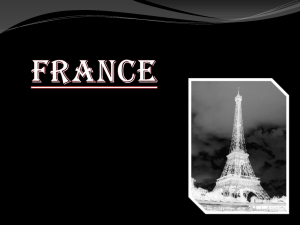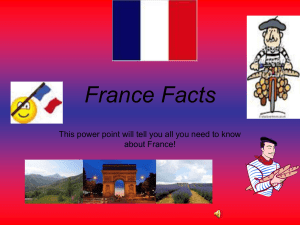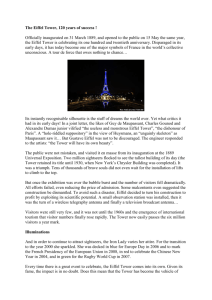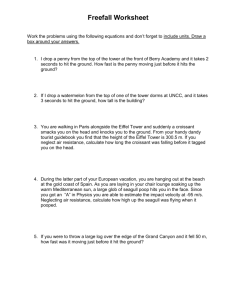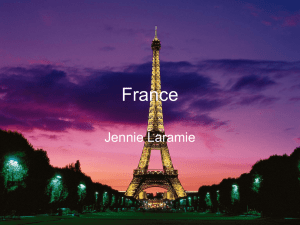Relational Looking and the Reversibility Constraint
advertisement
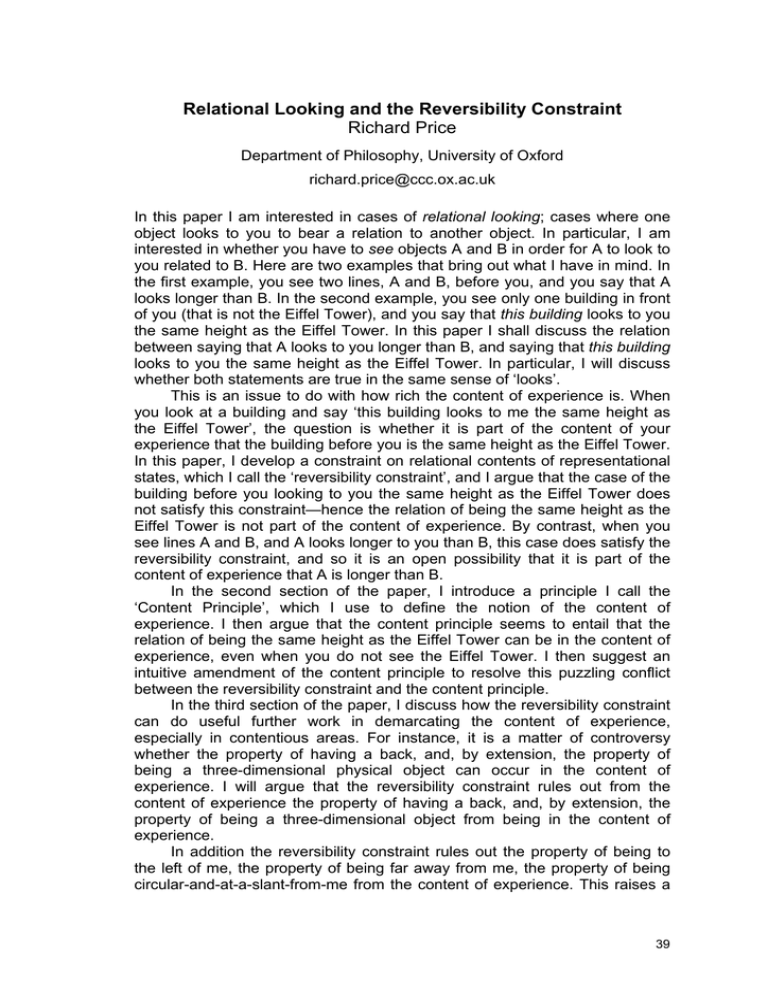
Relational Looking and the Reversibility Constraint Richard Price Department of Philosophy, University of Oxford richard.price@ccc.ox.ac.uk In this paper I am interested in cases of relational looking; cases where one object looks to you to bear a relation to another object. In particular, I am interested in whether you have to see objects A and B in order for A to look to you related to B. Here are two examples that bring out what I have in mind. In the first example, you see two lines, A and B, before you, and you say that A looks longer than B. In the second example, you see only one building in front of you (that is not the Eiffel Tower), and you say that this building looks to you the same height as the Eiffel Tower. In this paper I shall discuss the relation between saying that A looks to you longer than B, and saying that this building looks to you the same height as the Eiffel Tower. In particular, I will discuss whether both statements are true in the same sense of ‘looks’. This is an issue to do with how rich the content of experience is. When you look at a building and say ‘this building looks to me the same height as the Eiffel Tower’, the question is whether it is part of the content of your experience that the building before you is the same height as the Eiffel Tower. In this paper, I develop a constraint on relational contents of representational states, which I call the ‘reversibility constraint’, and I argue that the case of the building before you looking to you the same height as the Eiffel Tower does not satisfy this constraint—hence the relation of being the same height as the Eiffel Tower is not part of the content of experience. By contrast, when you see lines A and B, and A looks longer to you than B, this case does satisfy the reversibility constraint, and so it is an open possibility that it is part of the content of experience that A is longer than B. In the second section of the paper, I introduce a principle I call the ‘Content Principle’, which I use to define the notion of the content of experience. I then argue that the content principle seems to entail that the relation of being the same height as the Eiffel Tower can be in the content of experience, even when you do not see the Eiffel Tower. I then suggest an intuitive amendment of the content principle to resolve this puzzling conflict between the reversibility constraint and the content principle. In the third section of the paper, I discuss how the reversibility constraint can do useful further work in demarcating the content of experience, especially in contentious areas. For instance, it is a matter of controversy whether the property of having a back, and, by extension, the property of being a three-dimensional physical object can occur in the content of experience. I will argue that the reversibility constraint rules out from the content of experience the property of having a back, and, by extension, the property of being a three-dimensional object from being in the content of experience. In addition the reversibility constraint rules out the property of being to the left of me, the property of being far away from me, the property of being circular-and-at-a-slant-from-me from the content of experience. This raises a 39 question about what kinds of location properties objects can look to have. I discuss the options, absolutist and relationalist location properties, and I reject both. Using the reversibility constraint, I also reject the notion that objects look to be at certain visual angles from us. This leads to a puzzle that lies unresolved at the end of the paper, namely what kinds of location properties objects do look to have. I Consider S’s belief that A is the same height as B. This is a belief with a relational content. When S believes that A is the same height as B, she believes something about A, and she also believes something about B. What she believes about B is that it is such that A is the same height as it. So, if A is believed by S to be the same height as B, then B is believed by S to be such that A is the same height as it. This principle holds as a matter of necessity: it would be nonsensical to say that you believe that A is longer than B, but you don’t believe anything about B. Necessarily, in believing that A is longer than B, you believe that B is such that A is longer than it. This principle seems to hold for all representational content. If A is represented as being taller than B, then B is represented as being such that A is taller than it; i.e. one can always reverse the order of A and B, to say how B is represented as being. Let us express this constraint on relational contents as follows: Reversibility Constraint: Necessarily, if A is represented as bearing relation R to B, then B is represented as being such that A bears R to it. A stronger version of the Reversibility Constraint may be true as well. You might think that, if someone believes that A is taller than B, then this is exactly the same as believing that B is less tall than A. Or that, if one believes that A is the same colour as B, then this is the same as believing that B is the same colour as A. Or that, if one believes that James hit Fred, then this is the same as believing that Fred was hit by James. The idea is that for every relation, R, that holds between A and B, there is a reverse relation, reverse-R, that holds between B and A. According to the stronger version of the reversibility constraint, if you believe that A bears R to B, this is the same as believing that B bears reverse-R to A. The weaker reversibility constraint does not require that you believe that B bears reverse-R to A. The weaker version merely requires that you believe that B is such that A bears R to it. It is a difficult question whether the stronger version of the reversibility constraint is true. There is some temptation to say that, if a subject believes that A bears a very complex relation R to B, she may not know whether this complex relation is symmetric or not, so she may not have a belief about whether B bears R to A. The stronger version of the reversibility constraint cannot accommodate this possibility. According to the stronger version, if R is a symmetric relation, then in virtue of believing that A bears R to B, S believes that B bears R to A. The counter-intuitiveness of this conclusion may, however, be tempered by the fact that the stronger version of the reversibility 40 constraint does allow for the possibility that the subject does not have any beliefs about whether R is a symmetric relation. This puzzle is not restricted to relational beliefs. If Susanna believes that it is not the case that Jim isn’t hot, is that the same as Susanna believing that Jim is hot? These are difficult issues to resolve, but fortunately we do not need to resolve them for our purposes. For our purposes, all that needs to be true is that, if A is believed to be taller than B, then B is believed to be some way: namely, such that A is taller than it. (I am grateful to Stephen Kearns here. The above are developments of an objection that he put to the stronger version of the reversibility constraint that made me think that a weaker version was needed). Take the example of the two seen lines, A and B, where A looks longer to you than B. For it to be in the content of your experience that A is longer than B, that content would have to satisfy the reversibility constraint. And that content does satisfy the reversibility constraint. For if A looks longer to you than B, then B looks to you to be such that A is longer than it. But consider the case where you are looking at a building before you and say ‘this building looks to me the same height as the Eiffel Tower’. Here the relational looks statement does not satisfy the reversibility constraint. One cannot say ‘the Eiffel Tower looks to me to be such that this building is the same height as it’, because the Eiffel Tower does not look any way at all to you at the time, since you don’t see it. Of course, there may a sense of the word ‘looks’ in which the Eiffel Tower looks to me such that this building is the same height as it. If this sense exists, it is the sense in which the Eiffel Tower tends to look to me such that this building is the same height as it. But this wasn’t the sense of ‘looks’ in the original looks-statement. When it was said that this building looks the same as the Eiffel Tower, this did not mean that this building tends to look to me the same height as the Eiffel Tower—after all, this building may not tend to look to me the same height as the Eiffel Tower. The point illustrated in the last paragraph can be made for the beliefs too. Imagine that the Eiffel Tower is believed by Fred to be taller than Canary Wharf is normally believed to be. (i.e. Fred believes that: the Eiffel Tower is taller than Canary Wharf is normally believed to be). The reversal of this content in accordance with the reversibility constraint is not: Canary Wharf is normally believed by Fred to be such that the Eiffel Tower is taller than it. After all, Canary Wharf might not be normally believed by Fred to be any way at all. Rather, the correct reversal is: the height Canary Wharf is normally believed to be is believed by Fred to be such that the height of the Eiffel Tower is greater than it. One might think that when we say ‘this building looks to me the same height as the Eiffel Tower’, what we really mean is that this building looks to me the same height as the Eiffel Tower normally looks. The above application of the reversibility constraint may have demonstrated that the perceptual content does not contain the relation of being the same height as the Eiffel Tower, but it may yet allow that the perceptual content contains the relation of being the same height as the Eiffel Tower normally looks. However, ‘this building looks to me the same height as the Eiffel Tower normally looks’ does not satisfy the reversibility constraint either. The correct reversal of the supposed content is not: the Eiffel Tower normally looks the 41 same height as this building. The correct reversal is rather: the height the Eiffel Tower normally looks to have looks to be such that the height of this building is the same as it. Even if it is intelligible for the heights of objects to look certain ways to you (as opposed to the objects themselves), the problem is the same one as before: the height that the Eiffel Tower normally looks does not look any way to you right now, since you do not see that height. What has been demonstrated thus far is that, when it is true that this building looks the same height as the Eiffel Tower, and you don’t see the Eiffel Tower, there is no experience with the content <this building is the same height as the Eiffel Tower>. And when it is true that this building looks the same height as the Eiffel Tower normally looks, and you don’t see the height that the Eiffel Tower normally looks, there is no experience with the content <this building is the same height as the Eiffel Tower normally looks>. II In section III, I intend to consider how the reversibility constraint can do further work in demarcating the content of experience. In this section, however, I will discuss a principle, that I call the ‘Content Principle’, that seems to conflict with the conclusion of section I; that is, the content principle seems to entail that even when you don’t see the Eiffel Tower, you can have an experience which includes as part of its content the relation of being the same height as the Eiffel Tower. This is puzzling, since both the reversibility constraint and the content principle seem to be true, and yet there is evidence that they conflict. Why do we believe that perceptual experiences have contents? What seems to be central to the idea that experiences have contents is that there is such a thing as an object being the way it looks, or failing to be the way it looks. For instance a square may look triangular, and thus not be the way it looks. The same idea makes us think that beliefs have contents: there is such a thing as an object being the way it is believed to be, or failing to be the way it is believed to be. Thus, central to the idea that experiences have content is the idea that how objects look places a condition on the objects, namely that the objects have to be a certain way to be the way they look. Let us spell out this intuition in the following principle: Content Principle: Necessarily, there is a sense of the actual sentence ‘A looks F’ which is true iff: (i) necessarily, if A looks F and A is not F, then A is not wholly the way it looks. (ii) necessarily, if A looks F and A is F, then A is partly the way it looks. In using the conditions in the content principle to give necessary and sufficient conditions for perceptual content, I have assumed that the veridicality conditions of a given experience are equivalent to the content of that experience, and hence there are no modes of presentation in the content of experience. I believe this assumption to be correct, though I do not have the 42 space to defend it here. In addition, the puzzle I set out below could be rephrased in terms of the veridicality conditions of experience, rather than its content. There will be some expressions of the form ‘A looks F’ which do not satisfy the two conditions in the content principle—i.e. cases where it is true to say ‘A looks F’, even though A does not have to be F to be the way it looks. The project of demarcating the content of visual experience is equivalent to the project of deciding for which statements of the form ‘A looks F’ the conditions in the content principle are satisfied. For example, the first section of this paper has argued that, if the Eiffel Tower is not seen, the sentence ‘A looks the same height as the Eiffel Tower’ cannot correctly report the content of visual experience. Therefore, when the Eiffel Tower is not seen, the statement ‘this building looks the same height as the Eiffel Tower’ will not be true in the sense of ‘looks’ defined by the content principle: i.e. it will not be the case that A has to be the same height as the Eiffel Tower to be the way it looks. In a way, this result is quite intuitive. Imagine a situation in which it is true that A looks the same height as the Eiffel Tower, even though we don’t see the Eiffel Tower. We wouldn’t count ourselves as misperceiving A if, in the course of our experience, the Eiffel Tower suddenly shrunk so that it was no longer the size of A—i.e. so that even though A looked the same height as the Eiffel Tower, it wasn’t the same height as the Eiffel Tower. This suggests that the truth that A looks to me the same height as the Eiffel Tower does not require that A be the same height as the Eiffel Tower to be the way it looks. At this stage, the results of the reversibility constraint seem to fit well with our intuitions about what would count as a misperception of A and what would not. However, the problem is that a respondent might object: but if the Eiffel Tower had suddenly shrunk during the course of our experience, then from then onwards, it would no longer be true that A looked the same height as the Eiffel Tower. The content principle only applies to cases where A does look the same height as the Eiffel Tower. In these cases where A does look the same height as the Eiffel Tower, we then ask, does A have to be the same height as the Eiffel Tower to be the way it looks? And it seems that the answer to this is ‘yes’. For the respondent will say that if A looks the same height as the Eiffel Tower, then if the Eiffel Tower has a height of H, it follows that A looks H. If A looks H, then A must be H to be the way it looks; and since H is the same height as the Eiffel Tower, it follows that A must be the same height as the Eiffel Tower to be the way it looks. Moreover, any world in which H equal to the height of the Eiffel Tower, but A looks H, will not be a world, according to the respondent, in which A looks the same height as the Eiffel Tower, and hence will be irrelevant to the question of whether the conditions in the content principle are satisfied. The respondent will argue that the point in this paragraph shows that condition (i) of the content principle is satisfied. The respondent has a good case for saying that condition (ii) of the content principle is satisfied too. If the Eiffel Tower is H, and A is the same height as the Eiffel Tower, then that means that A is H too; given that A looks H, it follows that A is partly the way it looks. Hence both conditions of the content principle have been met. Since the content principle was introduced to capture what we mean by perceptual content, it seems to entail that the 43 relation of being the same height as the Eiffel Tower is in the content of one’s experience. The puzzle, therefore, is that the reversibility constraint rules out the relation of being the same height as the Eiffel Tower from being in the content of visual experience when the Eiffel Tower is not seen. And yet the content principle, which is used to capture the notion of the content of experience, seems to allow that the relation of being the same height as the Eiffel Tower is in the content of experience even when the Eiffel Tower is not seen. I shall now suggest a possible resolution of this puzzle. Let us say that an object, A, looks F. When considering whether A has to be F to be the way it looks, what we must do is consider all those worlds in which A looks the same as it does when, in the actual world, A looks F. Call that set of worlds S1. Now we must consider all those worlds within S1 in which A is not F, and ask whether, in all those worlds, A is or is not the way it looks. If there are ~Fa-worlds in S1 in which A is nonetheless the way it looks, then the conditions in the content principle have not been satisfied, and ‘A looks F’ does not report the content of visual experience. What is in common amongst the worlds in S1 is that A looks the same as it does when, in the actual world, A looks F. Let us define S2 to be the set of worlds in each of which it is true to say that A looks F. What is key to resolving the puzzle is recognizing that S1 and S2 are not necessarily the same set. This is because there may be worlds in S1 in which A does not look F, even though in these worlds A looks the same as it does when, in the actual world, A does look F. This may sound bizarre. There is an intuitive principle, that, if two objects, A and B, look the same, then if it is true that A looks F, then it must be true that B looks F. Call this the ‘Looks the Same Principle’. What the puzzle brings out, I believe, is that the Looks the Same principle is false. An object, A, might look the same from t1 to t3. At t1, it was true to say ‘A looks the same height as the Eiffel Tower’. At t2, the Eiffel Tower shrinks in height, so that at t3, it is not true to say ‘A looks the same height as the Eiffel Tower’. However there is no change whatsoever in the way A looks from t1 to t3. This example is sufficient to show that the Looks the Same principle is false. Recognizing the falsity of this principle helps us to see how to resolve the puzzle. When considering whether A has to be the same height as the Eiffel Tower to be the way it looks, when it looks the same height as the Eiffel Tower, contrary to the content principle above, we should not consider the set of worlds in which A looks the same height as the Eiffel Tower. Rather, we should consider the set of worlds in which A looks the same as it does when, in the actual world, A looks the same height as the Eiffel Tower. This set, call it S3, will contain worlds in which A does not look the same height as the Eiffel Tower (because the Eiffel Tower is much smaller or bigger in those worlds compared with ours), but it looks the same as it does in worlds in which it does look the same height as the Eiffel Tower. This is the first step to resolving the puzzle. In S3, there will be a world, w, in which the Eiffel Tower has a height of ½ H, whereas in our world the Eiffel Tower has a height of H. Let us say that in w, A looks H, and is H, so it is the way it looks. w shows that the statement ‘A looks the same height as the Eiffel Tower’ does not report the content of experience, since in w, A looks the same as it does in the actual world, A is 44 also the way it looks, and A is not the same height as the Eiffel Tower. In general, if A looks F, and we ask whether A has to be F to be the way it looks, we clearly have to keep the ‘look’ of A fixed. But the way to do this is not to keep fixed all of the truth-values of looks-statements involving A. That is what created the puzzle above. Rather, what we have to do is draw on our grasp of what it is for A to look the same that is independent of keeping all the truthvalues of looks-statements about A fixed. This is another way of saying that the Looks the Same principle articulated above is false. The correct formulation of the content principle is as follows: Content Principle*: Necessarily, there is a sense of the actual sentence ‘A looks F’ which is true iff: (i) necessarily, if A looks the same as it does when, in the actual world, it looks F and A is not F, then A is not wholly the way it looks. (ii) necessarily, if A looks the same as it does when, in the actual world, it looks F and A is F, then A is partly the way it looks. Rather than conflicting with the reversibility principle, the content principle* supports the conclusion that, when the Eiffel Tower is not seen, one’s visual experiences do not include in their contents the relation of A being the same height as the Eiffel Tower. This is because of worlds such as w above, in which A looks the same as it does when, in the actual world, it looks the same height as the Eiffel Tower, and in which A is the way it looks, and in which A is not the same height as the Eiffel Tower. III In this section I will discuss some further work that the reversibility constraint can do in demarcating the content of experience. There is a question as to whether experience represents things as tomatoes, tables and persons, or whether experience represents a much sparser range of properties, for instance colours and shapes. As the content principle illustrates, what these questions amount to is asking whether it is ever the case that an object has to be, say, a tomato to be the way it looks. Of course, we do say sentences such as ‘A looks to be a tomato’, but the question is whether these sentences are ever true in the sense that A has to be a tomato to be the way it looks. It seems that part of what would be involved in representing an object as a tomato would be representing the object as a three-dimensional physical object; and part of what is involved in representing an object as a threedimensional physical object would be representing the object as having a back.. This is where the reversibility constraint does some work. Just as the statement ‘I have a hand’ expresses a relation between me and one of my parts, so the statement ‘this object has a back’ expresses a relation between it and one of its parts. For that relation to be part of the content of experience, it would have to be reversible, i.e. if the sentence ‘this object looks to me to have a back’ is true, then the sentence ‘a back looks to me to be such that this object has it’ will be true. Yet, the latter sentence will not be true, since if I 45 do not see the back of the object, a back does not look any way to me at all. Therefore the reversibility constraint entails that, when we do not see the backs of objects, our experiences do not represent that the objects have backs. We often say sentences such as ‘this objects looks to the left of me’. Is it part of the content of my visual experience that the object is to the left of me? According to the reversibility constraint, this relation is part of the content of experience only if one can reverse the relata in the relation and say ‘I look to be such that this object is to the left of me’. However, if I do not see myself, I do not look to myself to be any way at all. For similar reasons, the sentence ‘A looks far away from me’ will not truly report the content of experience, since I do not look to myself to be such that A is far away from me. And the same points apply to ‘A looks in front of me’. The reversibility constraint also rules out the sentence ‘this coin looks to me circular-at-a-slant’ from reporting the content of experience, since that sentence is elliptical for ‘this coin looks to me circular-at-a-slant-from-me’, which will not be reversible if I do not see myself. One might think that the reversibility constraint allows the sentence ‘A looks further away than B’ to report the content of experience, if A and B are both seen. But in fact this statement is elliptical for ‘A looks further away from me than B’, and this statement is not reversible if I do not see myself. Similarly, even if one sees A and B, that does not mean that the sentence ‘A looks to the left of B’ can correctly report the content of experience, since that sentence is elliptical for ‘A looks further to my left than B’, and this statement is not reversible if I do not see myself. If one is unable to use properties such as being to the left of me to characterize the locations objects look to be in, how should one characterize these locations? One idea would be to use the notion of a visual angle. An object might look to be at a certain angle, say 90 degrees. But being at 90 degrees is really the relation of being at 90 degrees from me (I am grateful to Hemdat Lerman here). Hence, the reversibility constraint entails that objects do not look to be at 90 degrees from me, if I do not see myself. This raises the question: when we talk about objects looking to be at certain locations, what kinds of properties do we mean? According to relationalists, the property of being at a certain location is a matter of standing in relations to other objects in the world. However, given that one does not see all the objects in the world, the reversibility constraint would rule out relationalist location properties from being in the content of experience. According to absolutists, space is considered to be analogous to a large container, and every point in space has an absolute xyz coordinate, where the relevant axes are taken to be analogous to the sides of the container. Might visual experience represent absolutist location properties? It seems that an absolutist could not provide a full account of the location properties in experience, for the following reason. Imagine that I am looking at a red square on my left and a green square on my right. If I then move round and look at them from the opposite perspective, the way things look change. However, if experience represents absolutist location properties, then the content of experience has not changed at all, since the objects will still look to be in the exactly the same absolute location as they looked to be in from the original perspective. The absolutist is unable to explain how the way things 46 look seems to change as one switches perspective on the same set of objects. This latter example also makes another point clear. Whatever location properties visual experience does represent, they must be such that, when two people are looking at the two coloured squares from opposite angles, the location properties the squares look to have are such that the squares can actually have them. We do not want to be forced to say that there is only one perspective from which one can veridically perceive the squares’ locations. The points in the above two paragraphs can be combined to specify the two roles that must be played by the location properties that objects look to have. Firstly, they must be able to explain how the way things look changes as your perspective changes; secondly, the location properties that an object is represented as having by experiences from multiple perspectives must be capable of being had by one and the same object (i.e. experiences from multiple perspectives must be capable of all being veridical). The puzzle is that the properties that seem ideally suited to play these two roles are properties such as ‘being to the right of me at such and such an angle’; and yet, the reversibility constraint rules out these kinds of properties from being in the content of experience. Thus, what kinds of location properties are represented by experience? Given how closely related size and location properties are, we can ask: what kinds of size properties are represented by experience? These seem to me to be extremely interesting questions, and ones that deserve some further investigation. Before finishing I will mention two further accounts that are in conflict with the reversibility constraint. The first is the relational view of colour properties. Some hold that being red is the property of looking red to normal observers in normal conditions. If one accepts the assumption there are no modes of presentation in the content of experience (and, it seems that there is some pressure to do this if one believes in a nonconceptual theory of perceptual content—after all, what could these modes of presentation be other than concepts?), then, on this view, representing something as red is a matter of representing the thing as looking red to normal observers in normal conditions. Yet representing this latter relation would violate the reversibility constraint, given that you do not see normal observers whenever things look red to you. The second account in conflict with the reversibility constraint is John Searle’s account of perceptual content. In order to rule out the possibility of veridical hallucination, John Searle claimed that one’s experiential contents have an implicit causal and self-referential component (Searle, 1983). He claimed that, when you are looking at a yellow car before you, the content of your experience is <there is a yellow car before me that is causing this experience>. However, given that one does not see one’s own experiences, the reversibility constraint would rule out from the content of experience the relation of causing one’s experiences. One’s experiences do not look to one to be such that the object before one causes them. The reversibility constraint seems an essential constraint on the relational contents of representational states. It has been shown to do much useful work in clarifying what belongs in the content of experience and what does not. It has also raised some very interesting questions regarding what 47 kinds of location and size properties experience represents, and these questions will be the subject of further investigation. Reference J. Searle, Intentionality, 1983, CUP. 48
